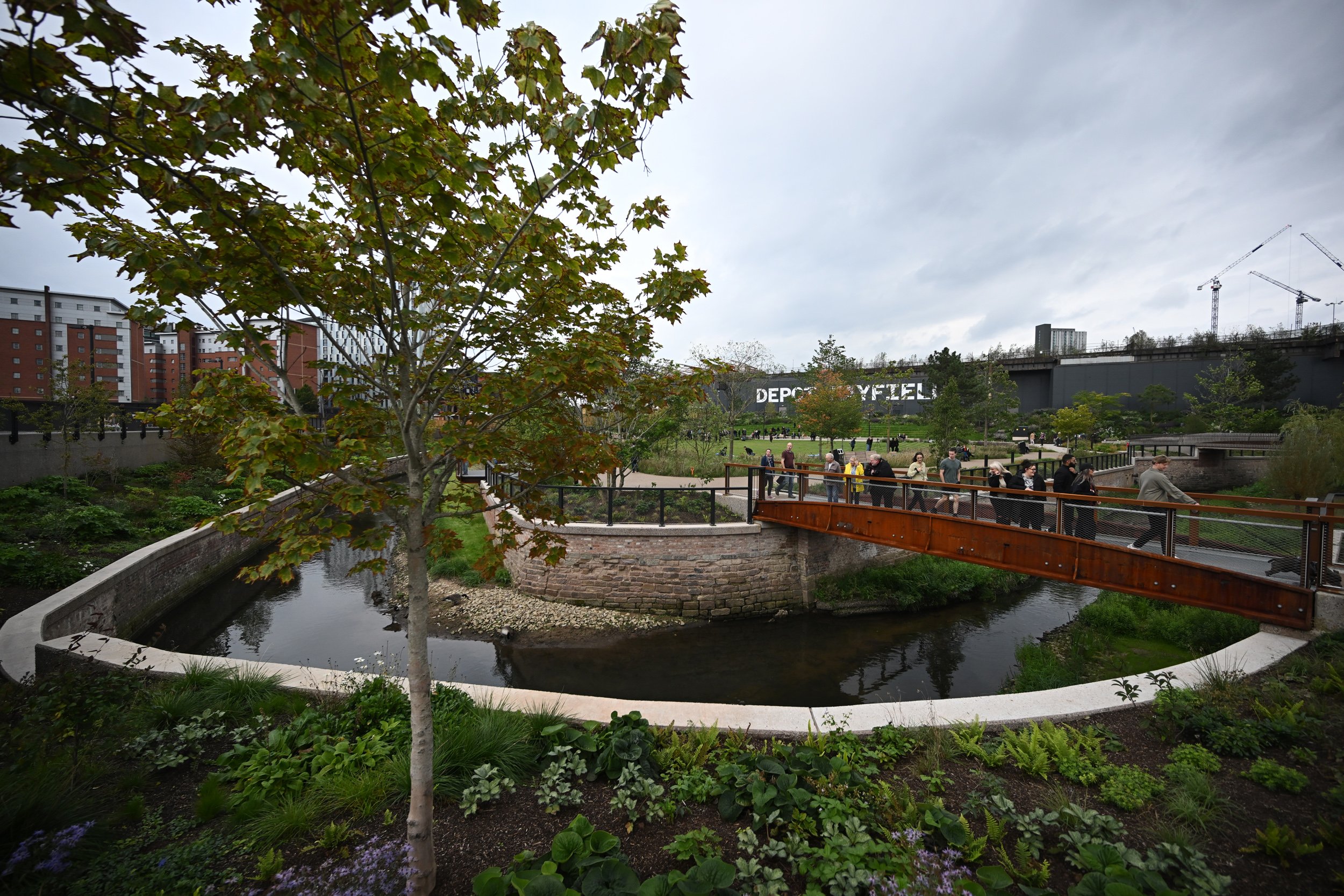Mayfield Park
Located in Manchester City Centre to the north of Ardwick and south of Piccadilly, Mayfield is a £1.4bn commercial-led regeneration scheme with a new park at its heart.
The first phase of development secured planning permission in February 2020 and delivery of the proposals are currently underway.
The first element to be brought forward is the 6.5 acre Mayfield Park, centred around the newly-exposed River Medlock (it was under a concrete culvert until 2021), which completed construction in September 2022.
Brownfield regeneration
The Mayfield redevelopment has become an an exemplar of brownfield regeneration. The land was contaminated due its former use in the 19th century as the Hoyle Street Dye Works.
The site was also used as workers’ housing and associated infrastructure. In the 1960s, the site was redeveloped for industrial, warehousing and distribution uses.
Many of these uses were linked to the former operation of Mayfield Railway Depot, which ceased activity in 1986.
Nature has been at the heart of the recovery of the park and starts to set the example of how the rest of the Mayfield development should come forward in the future.
Flood mitigation
The redeveloped park incorporates complex flood mitigation measures to ensure that areas of the River Medlock both upstream and downstream are not flooded by new development taking place at Mayfield. The northern end of the park effectively acts as a flood plain, with flood resistant planting and rain gardens to gradually allow water to drain from the site.
The River Medlock itself was extensively cleaned as part of the works, with nature finding its way and fish beginning to recolonise. Kingfishers and Herons have also been spotted on site, as well as more common geese and ducks. A dark corridor is provided through bespoke lighting, ensuring that bats can continue to roost and forage in the area.
In addition to the 120,000 plants, flowers and shrubs that have been planted are now growing in the park, there are 140 new mature trees in key locations and provide interest all year round.
By re-using all site won materials and remediating these on site as engineering fill, a significant amount of embodied carbon was saved during the construction process. To add to the overall reduction, existing river walls were reused, bridges were refurbished, and the structural components of the former river culvert were reused to make new bridges. The proposals also reutilised the old Victorian wells, used when the site was a dyeworks and later a brewery, to provide irrigation and cleaning for the park.
Improving public amenity
Further to the ecological and environmental benefits of the new park, a world-class play area has been delivered. This locally sourced and bespoke play equipment references the site’s former heritage as a dyeworks; reflecting the geometry of the former chimneys on site. Some of the play equipment uses salvaged bricks which were reclaimed from the 1960s warehousing previously on site. All furniture on site has re-used old dockyard fenders from the Netherlands, repurposed to provide seating and benches. This approach demonstrates how every feature in the park has been designed with sustainability in mind.
There were significant challenges to overcome during the delivery of this first phase of the project, but collaboration between public, statutory and private organisations has allowed the aims to be fulfilled. The Park will become the future sustainable heart of this new city centre neighbourhood.
Further information:
Mayfield home (mayfieldmanchester.co.uk)
Mayfield (@MayfieldMCR) / Twitter
Delivery Team
Mayfield Development Partnership comprising: Regeneration specialist U+I (a Landsec company), Manchester City Council, London Continental Railways and Transport for Greater Manchester.
Design Team
Lead Designer – Studio Egret West
Civil and Structural Engineering – BuroHappold and Civic Engineers
Contractor – PP O’Connor
Planning Consultant – Deloitte
Ecologist – BuroHappold
Acknowledgement
Case study was written with the support of The Mayfield Development Partnership.
Project Photographs
Reproduced, with permission, The Mayfield Development Partnership.




